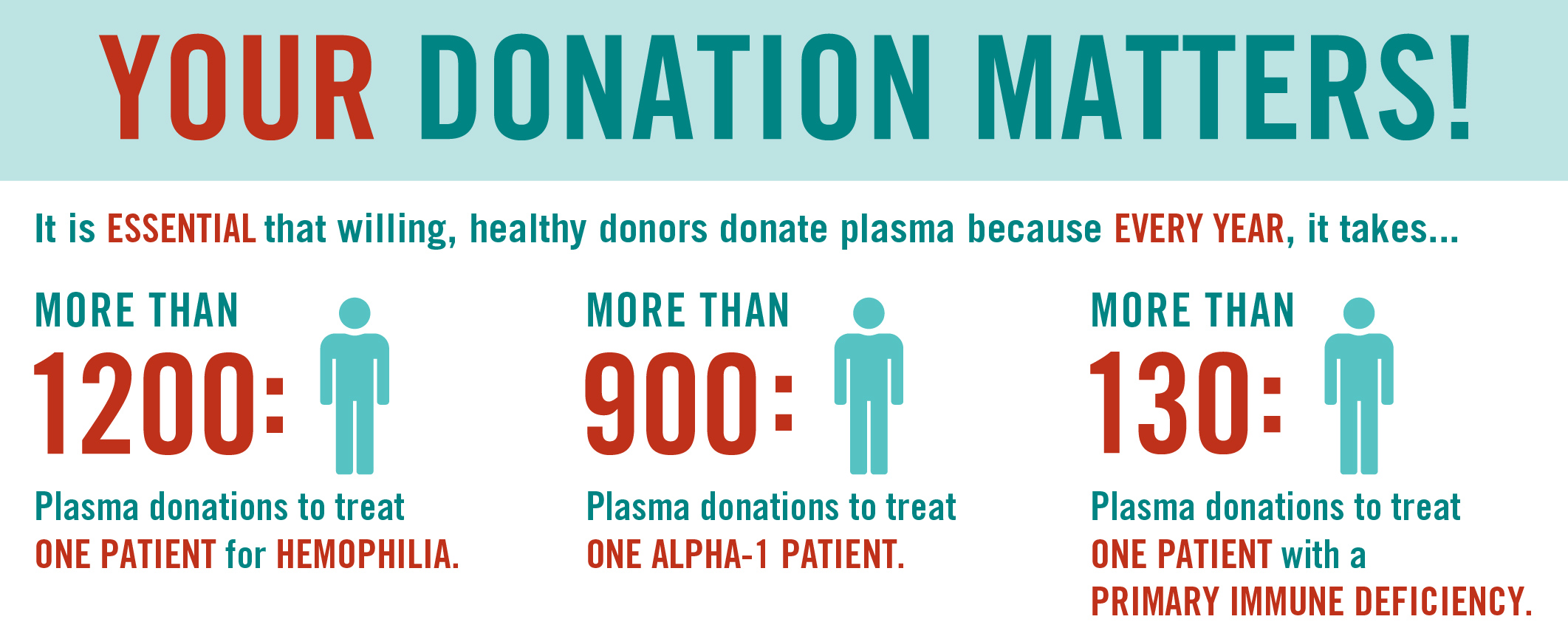What is Plasma Donation and How Does it Work?
Plasma donation is a vital process that involves collecting the liquid portion of blood, known as plasma, from donors. This plasma is then used to create life-saving therapies for patients with rare and serious diseases, such as hemophilia and immunodeficiency disorders. The plasma donation industry has experienced significant growth in recent years, with an increasing demand for plasma-derived therapies.
The process of plasma donation is relatively straightforward. Donors visit a plasma donation center, where they undergo a brief medical examination and screening process to ensure their eligibility to donate. Once cleared, the donor’s plasma is collected through a process called plasmapheresis, which separates the plasma from the other blood components. The plasma is then frozen and shipped to a manufacturing facility, where it is used to create various therapies.
Plasma donation centers use specialized equipment to collect and process the plasma, ensuring the highest level of safety and quality. Donors are typically compensated for their time and effort, with payment rates varying depending on the location, weight, and frequency of donation. For those wondering how much they can make donating plasma, the answer varies, but it can be a lucrative way to earn extra income.
The plasma donation industry is regulated by strict guidelines to ensure the safety of both donors and patients. Donors must meet specific eligibility requirements, including age, weight, and medical history, to ensure the quality of the plasma collected. The screening process typically includes a medical questionnaire, blood test, and physical examination.
As the demand for plasma-derived therapies continues to grow, the plasma donation industry is expected to expand, providing more opportunities for donors to contribute to life-saving treatments. By understanding the process of plasma donation and the importance of this vital resource, individuals can make informed decisions about becoming a plasma donor and earning extra income in the process.
How Much Can You Earn Donating Plasma: Factors Affecting Payment
When considering plasma donation as a way to earn extra income, it’s essential to understand the factors that influence payment rates. The amount of money you can make donating plasma varies depending on several factors, including location, weight, and frequency of donation. Plasma donation centers also have different payment structures, which can affect how much you can earn.
Location is a significant factor in determining payment rates. Plasma donation centers in urban areas tend to pay more than those in rural areas. For example, a plasma donation center in New York City may pay up to $50 per donation, while a center in a smaller town may pay around $20 per donation. Weight is also a factor, as donors who weigh more tend to produce more plasma and can earn higher payments.
Frequency of donation is another factor that affects payment rates. Donors who donate regularly can earn more money than those who donate sporadically. Some plasma donation centers offer loyalty programs or bonuses for frequent donors, which can increase earnings. For instance, a donor who donates twice a week can earn up to $100 per week, while a donor who donates once a month may earn around $20 per month.
Payment rates also vary depending on the plasma donation center. Some centers pay more than others, and some may offer additional incentives or bonuses. For example, Grifols, a leading plasma donation center, pays up to $40 per donation, while BioLife, another prominent center, pays up to $30 per donation. CSL Plasma, a global plasma donation center, pays up to $25 per donation.
To give you a better idea of how much you can earn donating plasma, here are some approximate payment rates for different plasma donation centers:
- Grifols: $30-$40 per donation
- BioLife: $25-$35 per donation
- CSL Plasma: $20-$30 per donation
- Other centers: $15-$25 per donation
Keep in mind that these are approximate payment rates and can vary depending on the location and other factors. If you’re wondering how much you can make donating plasma, it’s best to check with your local plasma donation center for more information.
Top Paying Plasma Donation Centers: A Comparison
When it comes to plasma donation, it’s essential to choose a reputable and top-paying center to maximize your earnings. In this section, we’ll compare the payment rates and requirements of three leading plasma donation centers: Grifols, BioLife, and CSL Plasma.
Grifols is one of the largest plasma donation centers in the world, with over 200 locations across the United States and Europe. Grifols pays its donors up to $40 per donation, with the opportunity to earn more through their loyalty program. To be eligible to donate at Grifols, you must be at least 18 years old, weigh at least 110 pounds, and meet certain medical requirements.
BioLife is another prominent plasma donation center with over 100 locations across the United States. BioLife pays its donors up to $35 per donation, with the opportunity to earn more through their referral program. To be eligible to donate at BioLife, you must be at least 18 years old, weigh at least 110 pounds, and meet certain medical requirements.
CSL Plasma is a global plasma donation center with over 200 locations across the United States, Europe, and Asia. CSL Plasma pays its donors up to $30 per donation, with the opportunity to earn more through their loyalty program. To be eligible to donate at CSL Plasma, you must be at least 18 years old, weigh at least 110 pounds, and meet certain medical requirements.
Here’s a summary of the payment rates and requirements for each center:
| Center | Payment Rate | Eligibility Requirements |
|---|---|---|
| Grifols | Up to $40 per donation | 18+ years old, 110+ pounds, certain medical requirements |
| BioLife | Up to $35 per donation | 18+ years old, 110+ pounds, certain medical requirements |
| CSL Plasma | Up to $30 per donation | 18+ years old, 110+ pounds, certain medical requirements |
When choosing a plasma donation center, it’s essential to consider not only the payment rate but also the center’s reputation, location, and requirements. By doing your research and selecting a top-paying center, you can maximize your earnings and make the most of your plasma donation experience.
How to Maximize Your Earnings: Tips for Frequent Donors
As a frequent plasma donor, you can maximize your earnings by following a few simple tips. By maintaining eligibility, optimizing donation schedules, and taking advantage of referral programs, you can increase your earnings and make the most of your plasma donation experience.
Maintaining eligibility is crucial to maximizing your earnings. To do this, ensure you meet the eligibility requirements for plasma donation, including age, weight, and medical history. Additionally, make sure to follow the recommended donation schedule to avoid any deferrals or disqualifications.
Optimizing your donation schedule can also help you maximize your earnings. Consider donating during peak hours or on specific days when payment rates are higher. Some plasma donation centers offer bonus payments for donations made during these times, so be sure to check with your local center for more information.
Referral programs are another great way to maximize your earnings. Many plasma donation centers offer referral programs that reward donors for referring friends and family members. These programs can provide a significant boost to your earnings, so be sure to take advantage of them.
Here are some additional tips for frequent donors:
- Keep track of your donation schedule to ensure you’re donating at the optimal times.
- Take advantage of bonus payments for donations made during peak hours or on specific days.
- Participate in referral programs to earn rewards for referring friends and family members.
- Consider donating at multiple locations to increase your earnings.
- Keep your medical history and contact information up to date to avoid any deferrals or disqualifications.
By following these tips, you can maximize your earnings as a frequent plasma donor and make the most of your plasma donation experience. Remember to always prioritize your health and safety, and don’t hesitate to reach out to your local plasma donation center if you have any questions or concerns.
As you continue to donate plasma, you may wonder how much you can make donating plasma. The answer varies depending on several factors, including the location, weight, and frequency of donation. However, by following the tips outlined above, you can increase your earnings and make the most of your plasma donation experience.
The Benefits of Donating Plasma: More Than Just a Paycheck
While the financial rewards of plasma donation are certainly attractive, there are many other benefits to donating plasma beyond the paycheck. One of the most significant benefits is the opportunity to contribute to life-saving medical treatments. Plasma donations are used to create therapies for patients with rare and serious diseases, such as hemophilia and immunodeficiency disorders.
Donating plasma also provides a sense of community and connection among donors. Many plasma donation centers have a strong sense of camaraderie among donors, who often share their experiences and support one another. Additionally, donors may feel a sense of pride and fulfillment knowing that their donations are helping to save lives.
Furthermore, plasma donation can also have a positive impact on one’s own health and well-being. Donating plasma can help to reduce stress and anxiety, as well as provide a sense of purpose and meaning. Some donors also report feeling more connected to their community and more engaged in their own health and wellness.
In addition to the personal benefits, plasma donation also contributes to the advancement of medical research and treatment. Plasma donations are used to develop new therapies and treatments for a range of diseases and conditions, and can help to improve the lives of patients around the world.
While the question of how much can I make donating plasma is an important one, it’s also worth considering the broader benefits of plasma donation. By donating plasma, individuals can not only earn extra income but also contribute to the greater good and make a positive impact on the lives of others.
Some of the benefits of donating plasma include:
- Contributing to life-saving medical treatments
- Sense of community and connection among donors
- Positive impact on one’s own health and well-being
- Contribution to the advancement of medical research and treatment
- Opportunity to make a positive impact on the lives of others
Overall, donating plasma is a rewarding and fulfilling experience that offers many benefits beyond the financial rewards. By considering the broader benefits of plasma donation, individuals can make an informed decision about whether or not to donate and can feel confident in their choice.
Eligibility Requirements: Who Can Donate Plasma?
To be eligible to donate plasma, individuals must meet certain requirements. These requirements are in place to ensure the safety of both the donor and the recipient of the plasma.
Age: Donors must be at least 18 years old to donate plasma. Some plasma donation centers may have a maximum age limit, but this varies by center.
Weight: Donors must weigh at least 110 pounds to donate plasma. This is to ensure that the donor has a sufficient amount of blood to safely donate plasma.
Medical History: Donors must be in good overall health and pass a medical examination before donating plasma. This includes a review of their medical history, a physical examination, and a blood test.
Screening Process: The screening process for plasma donation typically includes a medical questionnaire, a physical examination, and a blood test. This is to ensure that the donor is healthy enough to donate plasma and that the plasma is safe for use in medical treatments.
What to Expect During the Initial Donation: During the initial donation, donors will be asked to provide identification and proof of age. They will then undergo a medical examination and screening process, which includes a review of their medical history, a physical examination, and a blood test. Once the donor has been cleared to donate, they will be seated in a comfortable chair and a needle will be inserted into a vein in their arm. The plasma will be collected using a process called plasmapheresis, which separates the plasma from the other blood components.
Eligibility Requirements for Plasma Donation:
- Age: 18 years old or older
- Weight: 110 pounds or more
- Medical History: Good overall health and pass a medical examination
- Screening Process: Medical questionnaire, physical examination, and blood test
By understanding the eligibility requirements for plasma donation, individuals can determine if they are qualified to donate and can make an informed decision about whether or not to donate. Remember, donating plasma is a safe and rewarding experience that can help to save lives.
Common Questions and Concerns: Addressing Donor Fears
As a potential plasma donor, you may have questions and concerns about the safety and impact of plasma donation on your overall health. In this section, we will address some of the most common questions and concerns among potential donors.
Safety: Is plasma donation safe?
Yes, plasma donation is a safe and well-established medical procedure. Plasma donation centers follow strict guidelines and protocols to ensure the safety of donors and the quality of the plasma collected.
Side Effects: What are the common side effects of plasma donation?
Common side effects of plasma donation include fatigue, dizziness, and bruising at the needle site. These side effects are usually mild and temporary, and can be alleviated by drinking plenty of water and taking a break after donation.
Impact on Overall Health: Will plasma donation affect my overall health?
No, plasma donation will not affect your overall health. Plasma donation is a safe and well-established medical procedure that is designed to collect a specific component of your blood, plasma, which is then used to create life-saving therapies.
Frequency of Donation: How often can I donate plasma?
The frequency of plasma donation varies depending on the plasma donation center and the individual donor’s eligibility. Typically, donors can donate plasma up to twice within a 7-day period, with at least 2 days in between donations.
Eligibility: What are the eligibility requirements for plasma donation?
To be eligible to donate plasma, individuals must meet certain requirements, including age, weight, and medical history. Donors must also pass a medical examination and screening process before donating plasma.
By addressing these common questions and concerns, we hope to alleviate any fears or worries you may have about plasma donation. Remember, plasma donation is a safe and rewarding experience that can help to save lives.
Common Questions and Concerns:
- Safety: Is plasma donation safe?
- Side Effects: What are the common side effects of plasma donation?
- Impact on Overall Health: Will plasma donation affect my overall health?
- Frequency of Donation: How often can I donate plasma?
- Eligibility: What are the eligibility requirements for plasma donation?
By understanding the answers to these common questions and concerns, you can make an informed decision about whether or not to donate plasma and can feel confident in your choice.
Conclusion: Turning Plasma Donation into a Lucrative Side Hustle
In conclusion, plasma donation is a viable side hustle opportunity that can provide a steady stream of income while also contributing to the development of life-saving medical treatments. By understanding the process of plasma donation, the factors that influence payment, and the eligibility requirements, individuals can make an informed decision about whether or not to donate plasma.
Additionally, by following the tips and strategies outlined in this article, frequent donors can maximize their earnings and make the most of their plasma donation experience. Whether you’re looking to supplement your income or simply want to contribute to a good cause, plasma donation is a rewarding and lucrative side hustle opportunity.
So, how much can you make donating plasma? The answer varies depending on several factors, including location, weight, and frequency of donation. However, by donating plasma regularly and taking advantage of referral programs and other incentives, individuals can earn a significant amount of money while also contributing to the development of life-saving medical treatments.
Final Tips and Recommendations:
- Research local plasma donation centers and their payment rates
- Understand the eligibility requirements and screening process
- Follow the tips and strategies outlined in this article to maximize earnings
- Consider donating plasma regularly to take advantage of referral programs and other incentives
By following these tips and recommendations, individuals can turn plasma donation into a lucrative side hustle opportunity that provides a steady stream of income while also contributing to a good cause.





